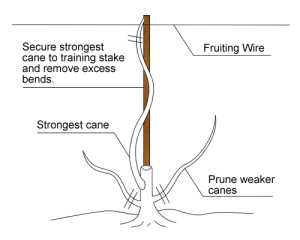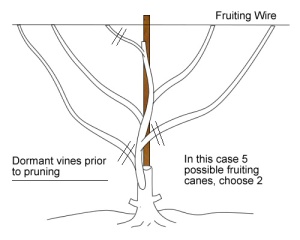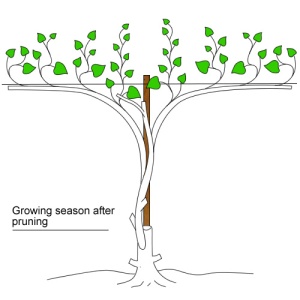Grape vine pruning is a relatively simple concept of which Grape vine growers seem to grasp fairly quickly.
Mother Nature takes care of the grape vines naturally during the winter as the vines go dormant and loose all their leaves.
About a month before spring, it is time to prune your grape vine.
Don’t let this scare you. Most new grape growers fail because they do not prune enough. It’s really simple, pruning and training are performed in order to optimize the production potential of the grape vine. Your objective is to maintain a balance between vegetative growth and fruiting.
Even more, pruning and training helps develop a structure that will aid the utilization of sunlight and help adapt to the characteristics of a particular grape variety. This will help you maintain economical and efficient vineyard practices.
Here are some simple guidelines that cover the basic principals of a Vertical Positioning System (VPS). In the VPS system canes are tied to the fruiting wire and shoots are tied off as they grow upwardly. The Vertical Positioning system is the easiest and most common system used worldwide.
First Year

Most nurseries supply already pruned dormant vines with two to three buds.
In your first growing season multiple shoots will begin to grow and the vine may become bushy. Some growers trim these back to just one or two shoots. Others prefer to let them grow so they may have a better selection to choose from during the following winter’s pruning.
Common vineyard practice is to allow at least two to four shoots to emerge. After the leaves have fallen the shoots are then referred to as canes. One or two of these canes will be chosen to establish the vine’s base trunk.
Year Two

Ok so during your first dormant pruning you’ll select one or two of the best canes and remove all the others. You’ll need to remove all lateral canes as well. Lateral canes develop from the node area of existing canes. When excessive sap is produced from the roots, shoot tips are unable to accommodate the new growth and lateral canes begin to grow throwing the vine’s overall growth out of balance.
Your goal is to achieve a balanced vine of just the right amount of leaves to fully ripen the grapes. Too much shade from vigorous leaf growth produces fewer grapes and less desirable grape qualities. Prune your best cane approximately 4-8″ below the fruiting wire at the nearest bud.
This cane should now be about the thickness of a standard lead pencil. If not prune back to healthy wood with a minimum of 3/8″ in diameter and start the process over again. Allow four to six shoots to grow from this cane during the next growing season.
Year Three Dormant Before Pruning

While the vine is dormant choose two of your thickest canes and prune away the rest.
Prune these two canes to an approximate length of 12-18″.
Year Three Dormant After Pruning

As you can see in this case, a spur was left at the top of the main cane as a possible fruiting cane if needed in the next growing season. The top area spur was chosen because it is well positioned for future use.
Begin training these two canes to the fruiting wire. As you may have noticed we are constantly removing wood. One of the biggest mistakes new grape growers make is not pruning and removing wood often enough. Pruning makes the vine hardier and stronger, it removes unwanted excess vegetation.
What’s more, good pruning techniques provide a much more balanced vine. Rub off canes that develop low on the trunk while they are still young. You don’t want them to reach ground and become Diseased during wet conditions.
Year Three Growing Season After Pruning
Allow eight to ten shoots to grow. These may possibly bear fruit the following growing season. Train these shoots to the other three catch wires of your trellis system.
The pruning and training techniques illustrated here are basically the same for the various training systems used worldwide. Once you understand the process you can pretty much prune and train any variety.
Climate, variety and soil fertility pretty much determine the rate at which your vines will progress. This a general guideline and these elements should be taken into consideration based on upon your particular circumstances.
Hybrid varieties were developed to be hardier during the winter and more resistant to diseases. They tend to produce less foliage then the traditional types of Grape vines. The annual pruning removes the previous years fruiting canes or spurs. Because fruit is only produced on shoots growing from one-year-old canes, healthy new canes must be produced by the vine every year.
Hand tools like loppers, hand pruners, and handsaws are typically used to prune Grape vines. The goal for the Grape vine owner is to avoid unnecessary injury to the plant. Most likely, when removing shoots that are one-year-old, hand pruners can be used effectively. On the other hand, larger wood should be cut with either the lopper or a handsaw.
Now that wasn’t so bad was it?





